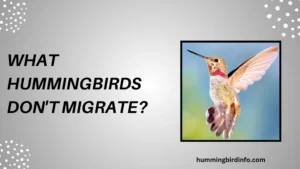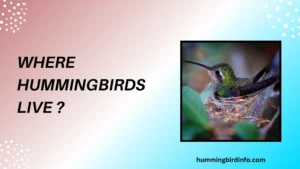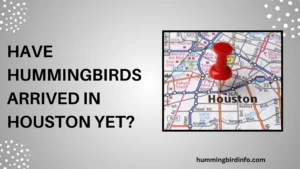Florida is home to lush gardens, tropical coastlines, and diverse ecosystems that attract not just sun-seekers, but also some of nature’s tiniest, most mesmerizing visitors — hummingbirds.
These tiny flyers, often mistaken for large insects, zip through the air with astonishing speed and grace, their iridescent feathers shimmering in the sunlight. Their sudden appearances can feel magical, leaving a lasting impression on anyone lucky enough to spot them.
You might wonder, “Are hummingbirds really in Florida?” The answer is a resounding yes — and not just in small numbers. From year-round residents to migratory guests, Florida plays host to several hummingbird species, making it a perfect place for both casual birdwatchers and passionate enthusiasts to witness their charm.
Whether you’re living in the heart of Miami or tucked away in the Panhandle, chances are you’ve already shared your space with these aerial acrobats.
This blog dives deep into the hummingbirds of Florida — who they are, when to see them, where they live, what they eat, and how to welcome them into your own backyard. By the end, you’ll not only know more about these fascinating creatures, but you’ll also feel inspired to help protect and preserve them across the Sunshine State.
Contents
- 1 Common Hummingbird Species in Florida
- 2 Seasonal Variations and Migration Patterns
- 3 Hummingbird Habitats and Food Sources in Florida
- 4 Attracting Hummingbirds to Your Florida Garden
- 5 Conservation and Challenges
- 6 Conclusion
- 7 FAQ’s
- 7.1 1. Do hummingbirds live in Florida year-round?
- 7.2 2. What is the most common hummingbird in Florida?
- 7.3 3. When is the best time to see hummingbirds in Florida?
- 7.4 4. Can I attract hummingbirds to my Florida yard?
- 7.5 5. What do hummingbirds eat besides nectar?
- 7.6 6. Are hummingbird feeders safe to use?
- 7.7
Common Hummingbird Species in Florida
Ruby-throated Hummingbird (Archilochus colubris)
- Most common species in Florida.
- Males have a bright ruby-red throat and emerald green back.
- Females are duller with a white throat and green upperparts.
- Seen breeding in spring and summer across the state.
- Known for their feisty, territorial behavior around feeders.
Rufous Hummingbird (Selasphorus rufus)
- Males have fiery orange feathers with a reddish throat.
- Seen primarily in winter, especially in northern and central Florida.
- Famous for having the longest migration of any hummingbird species.
Black-chinned Hummingbird (Archilochus alexandri)
- Males feature a black chin with a purple iridescent band.
- Not as common, but occasionally seen during migration.
- Adaptable and found in various habitats from woods to gardens.
Seasonal Variations and Migration Patterns
- Some Ruby-throated Hummingbirds stay year-round, especially in South Florida.
- Most arrive in spring to breed and depart in late summer to early fall.
- Rufous Hummingbirds often arrive in winter, escaping colder northern regions.
- Migration is guided by daylight changes and food availability.
- Feeders and blooming flowers can impact their migration timing slightly.
Hummingbird Habitats and Food Sources in Florida

Natural Habitats
- Found in gardens, parks, woodlands, and even wetlands.
- Thrive in areas with plenty of flowering plants and tree cover.
Native Nectar Plants
- Coral Honeysuckle (Lonicera sempervirens)
- Firebush (Hamelia patens)
- Cardinal Flower (Lobelia cardinalis)
Feeders
- Used as a supplement, especially when natural food is scarce.
- Offer a simple sugar solution to replicate flower nectar.
Insect Protein
- Hummingbirds eat gnats, mosquitoes, and spiders.
- Insects provide essential nutrients needed for health and breeding.
Attracting Hummingbirds to Your Florida Garden
Native Plants
- Choose colorful, tubular flowers that bloom in different seasons.
- Ideal plants include scarlet salvia, bee balm, and coral bean.
Feeders and Nectar
- Use a 1:4 sugar-water ratio (no red dye).
- Clean feeders every 2–3 days in warm weather.
Other Attractants
- Add a shallow birdbath or misting fountain.
- Avoid pesticides, which kill insects and contaminate food.
- Include shrubs and trees for shelter and nesting.
Conservation and Challenges
- Urban development reduces hummingbird habitats and food sources.
- Climate change may alter migration patterns and flowering cycles.
- Support groups like Audubon Florida and local wildlife centers.
- Plant native species and encourage others to build bird-friendly spaces.
- Small actions, like putting up a feeder or planting a bush, can make a huge impact.
Conclusion
Hummingbirds are alive and thriving in Florida, from the common Ruby-throated to the rare Rufous visitors. These birds not only beautify our gardens, but they also play an important role in the ecosystem as pollinators.
To keep them around, we must protect their habitats and support their needs year-round. That means planting native flowers, keeping feeders clean, and avoiding harmful chemicals.
Every Floridian has the chance to welcome hummingbirds into their life. With just a little effort, you can enjoy the thrill of their visits and help ensure that future generations can too. Let’s celebrate and protect these tiny jewels of the sky.
FAQ’s
1. Do hummingbirds live in Florida year-round?
Yes, Ruby-throated Hummingbirds can be seen year-round, especially in South Florida.
2. What is the most common hummingbird in Florida?
The Ruby-throated Hummingbird is the most widespread and frequent visitor across the state.
3. When is the best time to see hummingbirds in Florida?
Spring and fall migrations offer the best chance to see multiple species.
4. Can I attract hummingbirds to my Florida yard?
Yes, by planting native flowers, hanging feeders, and avoiding pesticides, you can attract them.
5. What do hummingbirds eat besides nectar?
They eat small insects like gnats and spiders for protein and nutrition.
6. Are hummingbird feeders safe to use?
Yes, if maintained properly. Use a 1:4 sugar-water mix, and clean feeders regularly.








